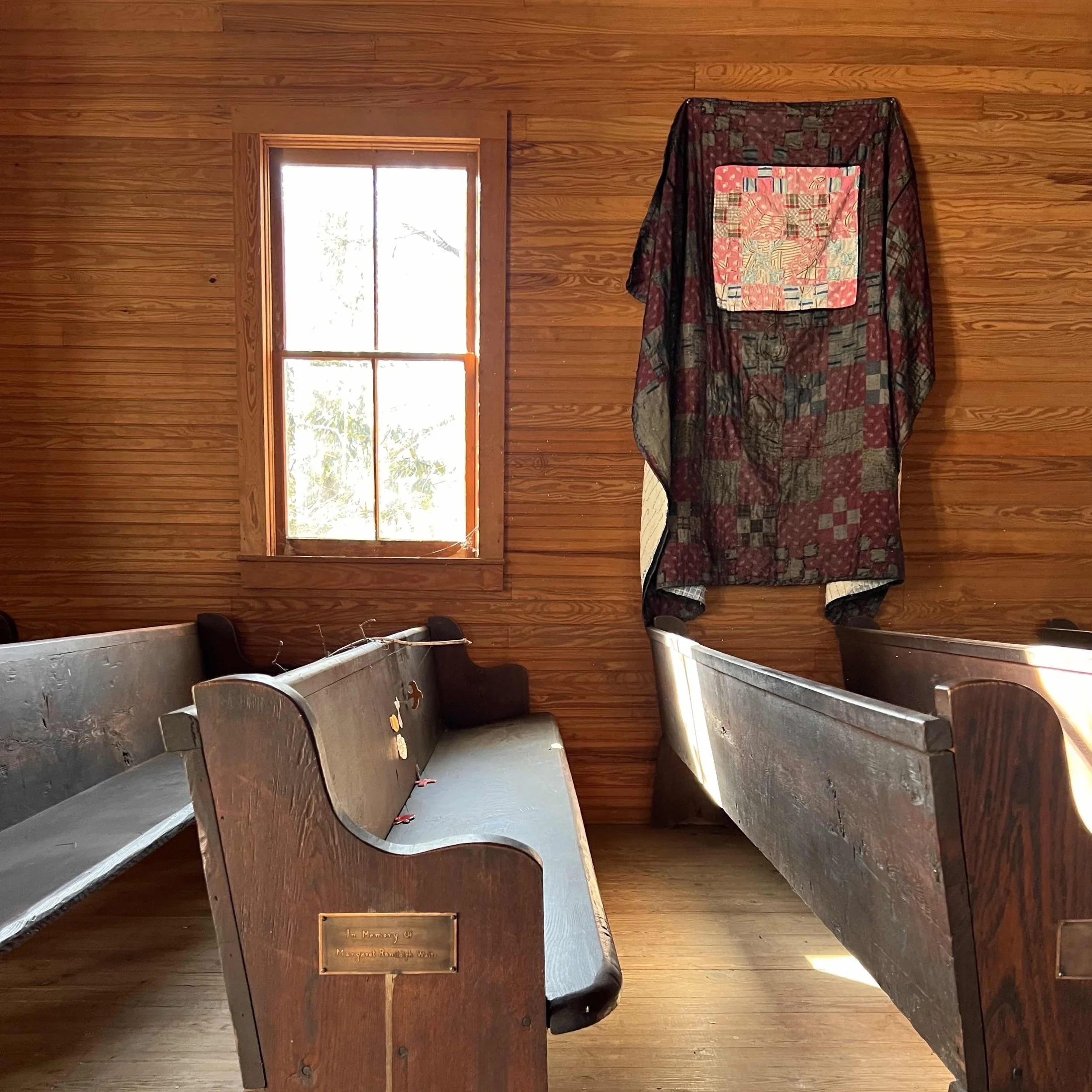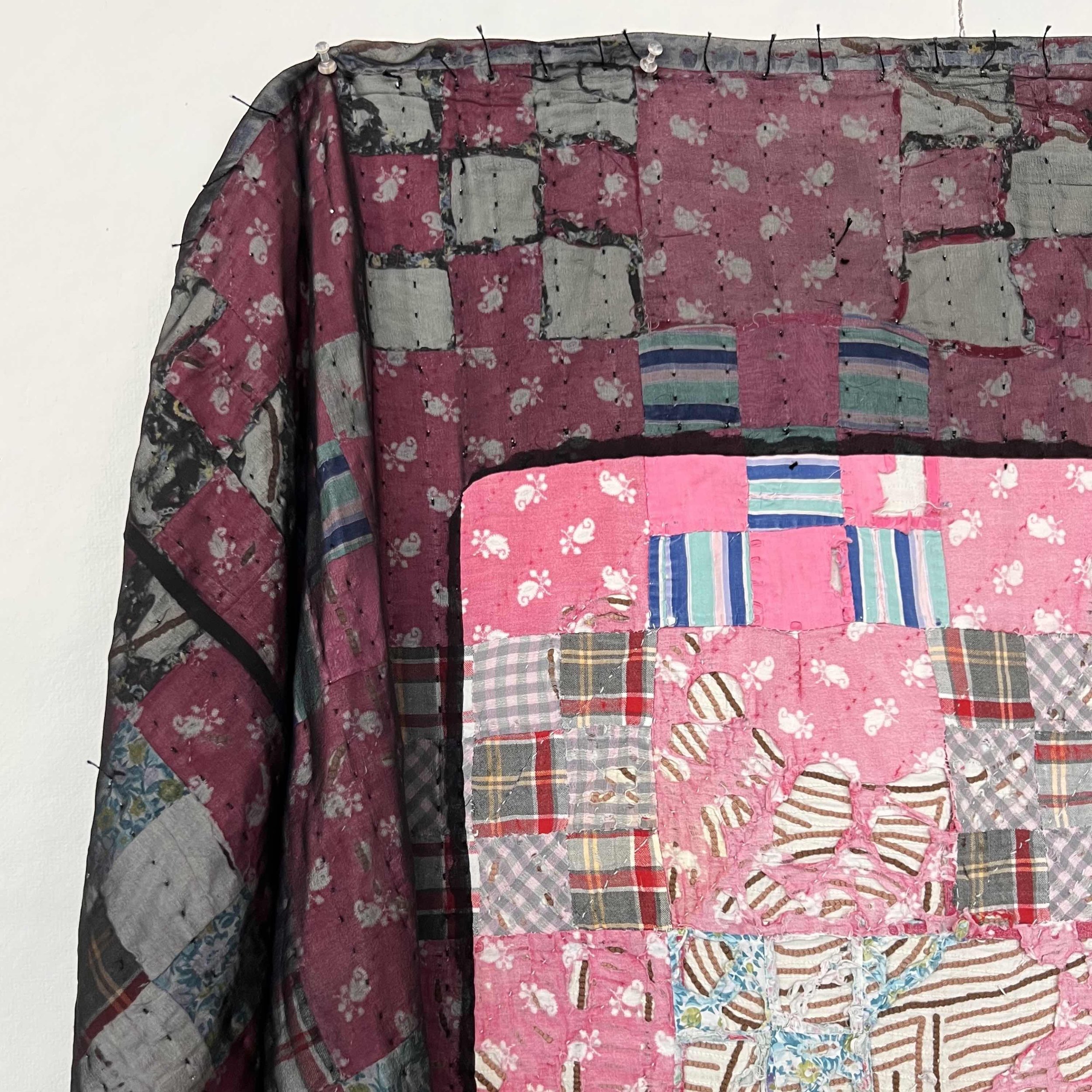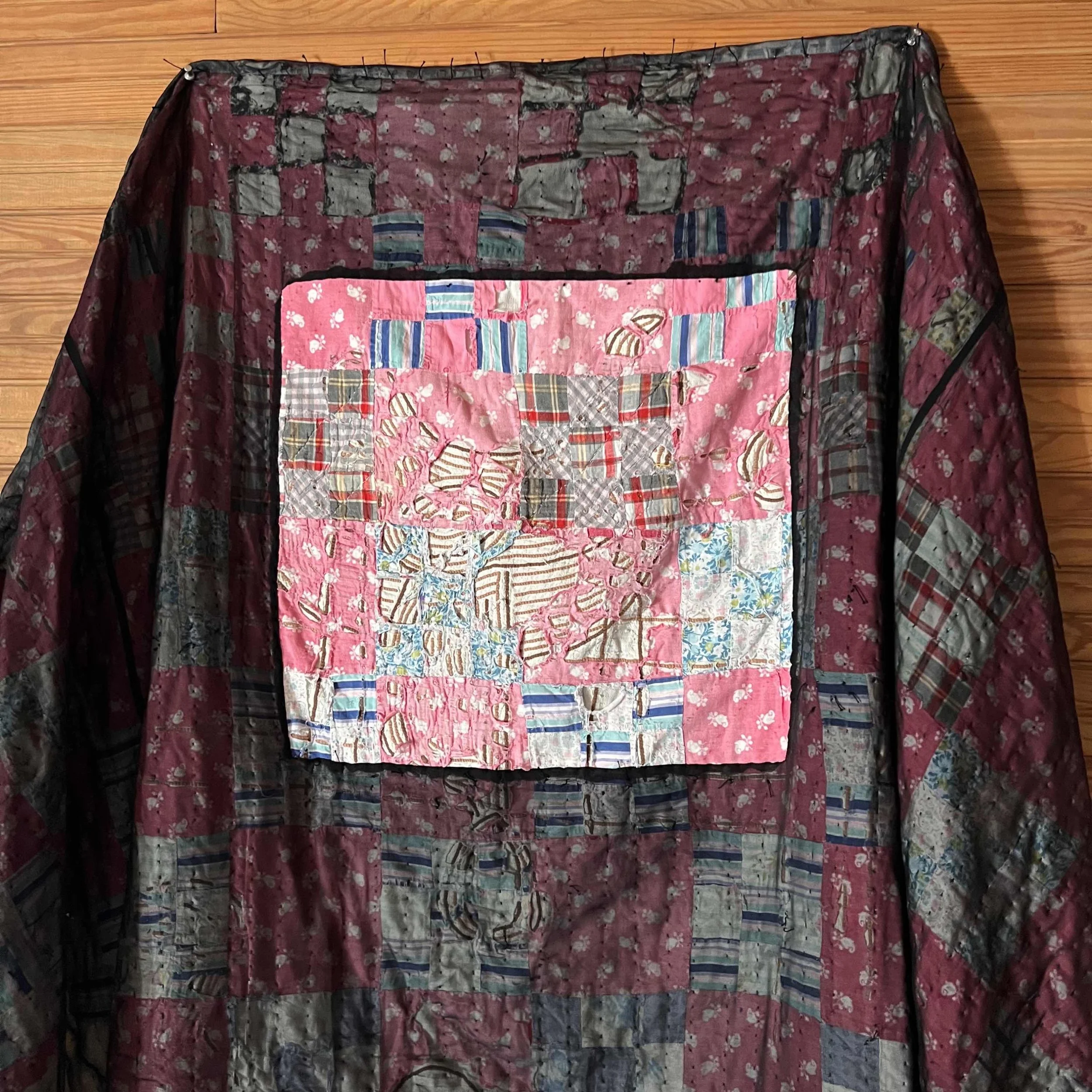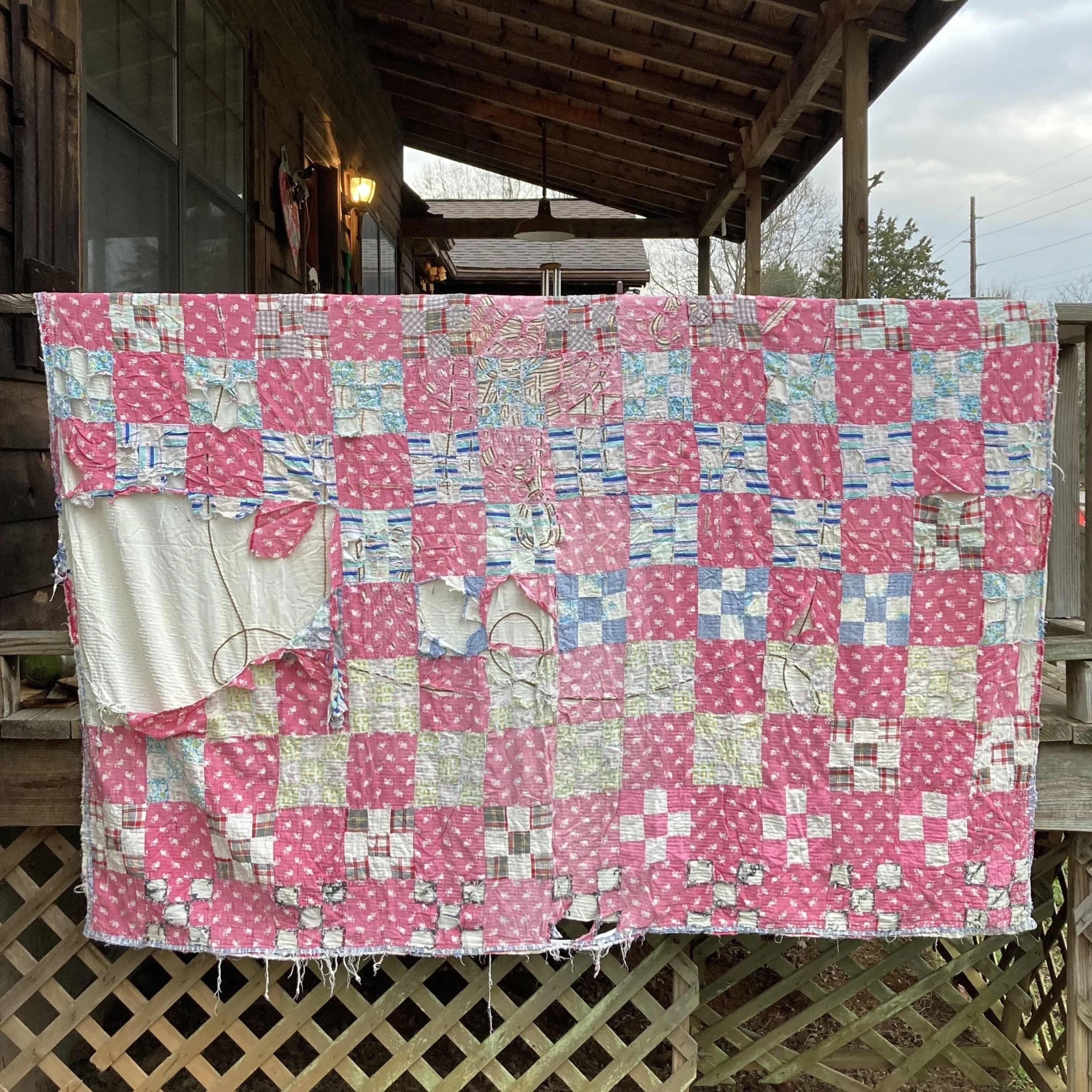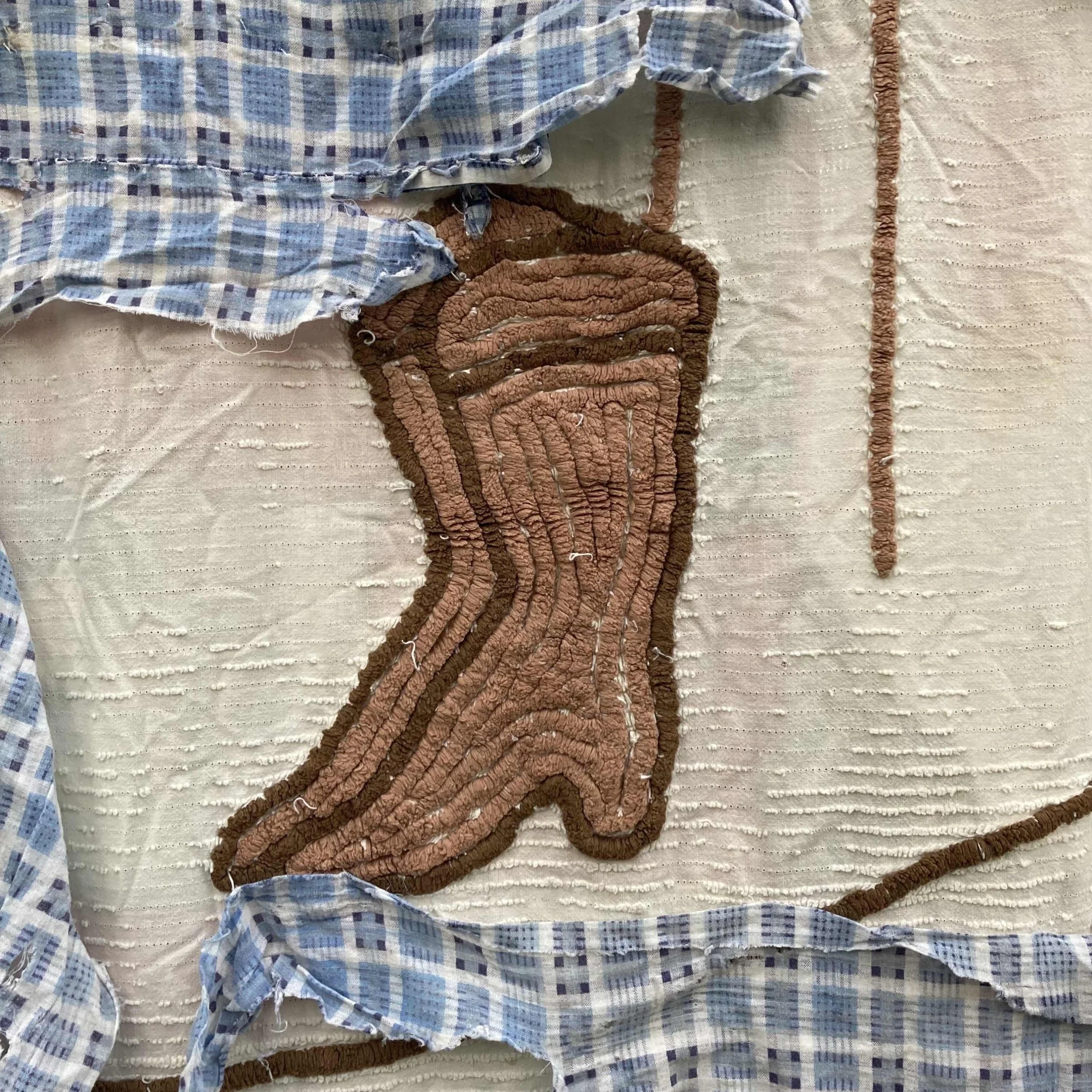GENERATION: Eroding Foundations and Making It Right
Time continually marching forward. Each new day just piles on top of yesterday and gets buried further back in what we have come to call history.
I think there's a problem with thinking about time that way, and that's what we're exploring today on SEAMSIDE. I'm going to share with you a quilt that I made called Generation. It's part of the Southern White Amnesia, a body of work that I've pulled together in the last couple years, exploring the stories that Southern White families tell each other and the ones they don't.
In this SEAMSIDE conversation, we explore: ① what to do with treasured but unusable family quilts ② how every quilt has something to teach us ③ how time plays with quilts
WHY LISTEN TO THIS EPISODE?
Explore the transformative power of quilting through GENERATION, a reconstruction of a cherished family quilt, weaving together narratives of Southern history, personal memory, and cultural inheritance.
REFLECTION PROMPT
How do you perceive the role of physical objects, like quilts or calendars, in marking historical and personal time? Can these items change the way you think about the past?
-
[00:00:00]
Maybe y'all know this about me, but I love crossword puzzles so much. So that for the last, I don't know, 10, 15 years, my mother in law has got us for the holidays, one of those one a day rip off calendars for the New York times crossword puzzles. And almost every night I'll sit down, I'll rip off a crossword puzzle, I'll sit there in bed and do it, and it'll be done. And the next morning I throw it away. That's our current calendar. Time continually marching forward. One day happens, and then it's done, and we're on to the next one, and then that one's done, and each previous day just gets buried further and further back in what we have come to call history.
I think there's a problem with thinking about time that way, and that's what we're exploring today on Seamside. I'm going to share with you a quilt that I made called Generation. it's part of the Southern White Amnesia body of work that I've pulled together in the last couple [00:01:00] years, exploring the stories that Southern White families tell each other and the ones they don't.
About their own origins. So far in this series, we've talked about other quilts like silver dollar, onus, snake handler, our children. I'm probably forgetting one, but if you like this quilt talk, just know there's others in this series that you can find in the feed below And I'm trying something new with this episode. So tell me if you like it. That is, as I mentioned, different parts of this quilt, I've embedded images into this podcast, so you can look down at your phone and hopefully see what I'm talking about. Let me know if you like it. Okay.
for now, sit back, relax, and let's think about generation.
I think the best way to start this story, ironically. It's chronologically. Let's talk about how this quilt was made about two or three years ago. I was helping my partner's family clean out their attic down in East Tennessee.
[00:02:00]
And they found bundled up in an old Ziploc bag. A quilt that his father had had when he was a boy back in the 1950s. The quilt had been made by my partner's grandmother. And it was this beautiful though, raggedy checkerboard nine patch affair, mostly pink with some white alternating. And when they first asked me if I wanted it, it was so raggedy as I politely declined, but the more I thought about it, the more I heard the voice of this quilt, heard what it could teach us.
blue
So fast forward a few months and I was at Penland Southern white amnesia had was just the seed of an idea in my mind. And I looked at this quilt and I saw something so raggedy. I was like, what can we do with you? Most of the quilt top. Had worn away at points. And that was due to the fact that my partner's grandmother had chosen an old chenille [00:03:00] bedspread.
if you're not familiar with chenille and that faddish bedspread craze of the mid fifties, it's a tufted velvety cord or yarn that was often put. into a bedspread to create some kind of intricate pattern. We could tell that there was an intricate pattern under this quilt top, but we had no idea what it actually was.
We know though that that tufted velvet, or whatever it was, had worn through grandma's quilt top that she had made, creating this really interesting pattern of abrasion that kind of gave you a sneak peek into the inner workings of that quilt.
it wasn't until I started ripping off the backing fabric, which was just, it had dry rotted over time. It came off in shreds. When I got that back fully off, I could see what it was. It was this. Fence, with an empty saddle and a cowboy hat hung on one of the posts.
We'll come back to that in a minute. [00:04:00] Funny enough though, this bedspread Must have been really big she had cut it in half So I'm wondering if there's another quilt floating around out there with the other half of this chenille bedspread But it was a few inches short of what she wanted and when I pulled off that backing fabric I discovered that there was this wedge this long Gentle triangle that filled out one of the corners of this quilt.
That was an old ACE bandage. The elastic was completely shot, but there was no denying that grandma had gotten scrappy and used what she had to make this quilt come together.
when I got the back ripped off and all cleaned up, and it was just the chenille bedspread and the abraded quilt top. I played around with adding text because, you know me. But I decided that what this quilt had to say spoke clearly enough on its own and quietly enough to encourage us to slow down and really contemplate it.
So after a couple [00:05:00] days of playing around with text, I tossed that idea and decided just to let the quilt be on its own. In the textile closet at Penland, there were bolts of so many beautiful fabrics. One of them was a bolt of black silk chiffon. And I love chiffon because it's translucent, and silk just feels so beautiful to the touch.
So I took four yards of that black silk chiffon and re quilted the entire quilt. I covered over all of grandma's quilt top, stitching it down, and you can still see grandma's quilt top just fine. It just looks a little Muted, a little grayed out. The whole quilt top didn't get covered though. I left a square open.
About two feet by two feet. Which created this masking like effect. If you've ever seen on TV or on a news website an official document where they want you to pay attention to one particular line. They [00:06:00] may gray out. A lot of the document, you can still kind of see it. But there's just this highlighted portion in the original white.
That to me is what the silk chiffon feels like it's doing for this quilt. It's treating it like a document with a story to tell, and it's highlighting a detail that I hope we'd all pay more attention to. I chose the particular part of the quilt to expose with the square, with this window, because that's where the most interesting part of the, Pattern of abrasion could be found it was where the chenille tufting was the densest and therefore had Really worn through that quilt top in ways that allowed the quilt top and the chenille bedspread To equally coexist.
So if generation is a document, what story does it tell? I think one of the stories it tells Is the beginning of an answer for when people say, Ooh, but that [00:07:00] time in history was so long ago as a part of Southern white amnesia, I'm thinking specifically of slavery days. I'm thinking of exploitation of native Americans.
People say that was so long ago, but here we're looking at this quilt that somebody made 75 some years ago. They made a single decision to use the chenille bedspread as the interior of this quilt. And that decision 75 years ago over the course of time has had a series of repercussions causing this quilt top to wear away, to erode, to abrade, revealing the foundation. I think there's an analogy here that we can think about in terms of our own society. Let's dig a little deeper.
If you've listened to the conversation on Onus, which is an alternative calendar of sorts, and I talk about that in that quilt talk, Onus shows us [00:08:00] how the past and the present live side by side. We know that. Generation here though, shows us not only that they exist side by side.
But it hints at why that matters to us. today is Passover. It's a day in the Jewish calendar that marks something important enough. Always to be remembered.
Holidays like this are mile markers.
They tell us that what happened is so important. We can't forget.
And that might be for a couple of different reasons. One, maybe forgetting is to our detriment. We'd be worse off if we didn't know this story. Or conversely, maybe remembering is for our good. What if remembering what happens? Helps us live in the fullness of time.
I heard a story on NPR yesterday. It's the mile marker project that's exploring different mile markers around the country. I think they said there's [00:09:00] 180, 000 or something crazy like that. This particular story though, focus on one just outside of Gadsden, Alabama, by the side of a road where every local knew something had happened there, but for the longest time, there was no marker To point at what occurred there on the side of the road. You see, William Moore was a mail carrier and a civil rights activist from Chattanooga. In 1963, he set out to make this great walk, walking all the way from Chattanooga down to Jackson, Mississippi, to deliver a letter denouncing segregation to the governor of the state.
He thought he could make a difference coming from the South. He thought he could speak the language.
but that day as he walked through Gadsden, Alabama, William Moore, male carrier and civil rights activist, 1963, was shot and laid
there on the side of the road.
There were never any convictions. But then in 2019, [00:10:00] along comes Jerry Smith. Jerry Smith said, it's been on my mind for over half a century. Jerry Smith single handedly at first pushed for a mile marker in William Moore's honor telling his story and finally got one a few years ago.
The reason I bring up Jerry and William here is this, there's a lot of questions we could ask about what happened in 1963, but the ones that I think most pertain to what we're talking about here today, how did the murder of William Moore change the fabric? Of that community.
How did the abiding silence afterwards further change the fabric Of that community.
And then lastly, how did the mile marker that Jerry Smith pushed for? Change the fabric Of that community.
Everything has an effect for ill or for good. What we do matters. Like Dr. Martin Luther King said, the time is always right [00:11:00] to do what is right. Even if it's been on your mind for over half a century, like Jerry Smith.
Now I'm thinking about doing what's right. You know, we've talked about silver dollar few episodes back in which I talk about how generational wealth accrued from the exploitation of black labor has passed down through my family through multiple generations, opening access to higher education, including my own to some degree. If wealth can pay forward through the generations, what else can?
There's a fascinating study in 2013 out of Emory University. A study on trauma, they took a bunch of mice, a bunch of male mice, and they would spray into their cage, the scent of cherry blossoms. And then right after smelling the cherry blossoms, those mice would get a little electric shock on their foot So real quick, they began to associate the pleasant smell of cherry blossom with the uncomfortable and [00:12:00] perhaps painful course of electricity through their body. Now, that in and of itself is interesting, butthey only shocked the first generation, yet the offspring, the second generation, whenever they would smell cherry blossoms, would tense up.
And not just the offspring, but the grandpups, the third generation, when they smelled cherry blossoms, They would tense up as well. Never having been shocked themselves, their parents had never been shocked. It was their grandparents, but something passed down epigenetically to this generation that continues to respond Based on patterns. That they wouldn't be able to trace back
in this country. We know that the enslaved obviously face trauma and so did whites for that matter. But I got a whole nother quilt about that. I'll only bring it up now to say that all flourishing is mutual. Racial equality [00:13:00] is not something that we do for the black community, for the descendants of the formerly enslaved.
It's something we do for our entire community because the ground that we stand on is underneath. all of our feet and we need to make sure that ground is good ground.
One time when I was a kid, I was out shopping with my mom. I was probably four years old or so we were at a clothes store. And I remember being mesmerized by this rack of jewelry. Now I look back and think, Oh, costume jewelry, right? But it was giant rhinestones, earrings and necklaces and bracelets.
And at a moment when my mom wasn't looking, I slipped a pair of those blue rhinestone earrings into my pocket.
I was four. I didn't mean anything by it. I just knew that I liked him and wanted to hold on to something pretty. So we walked out of the [00:14:00] store, got in the car, and I was in the back seat. Must have taken out those blue rhinestone earrings just to get a peek at my My new lute, you know. When my mom from the front seat saw what I held in my hands, she turned that car right around, drove back to the store, made me go inside, apologize, and then give back those blue rhinestone earrings.
As a kid, I was all torn up about it. I thought it was cruel and unusual punishment to have to go back and apologize and face facts and make good for it. But that's part of how we learn the difference between wrong and right, isn't it?
As a country, we've officially apologized for slavery back in 2008 and 2009.
The house and the Senate both passed bills with a formal apology. But part of that apology,
Very cleverly, includes that this would not form the basis for any future economic restitution. So we've [00:15:00] apologized, but we haven't made good. Not yet. But it's like Dr. King says, It's always the right time to do what is right.
Even if some folks might say, But that was so long ago.
In light of this historical neglect of justice, what's the room for reparations and all of this? In 2014, Ta Nehisi Coates wrote an essay, and That started a conversation that to this day has not stopped. That article was called a case for reparations and Coates said, and I quote here, my notion wasn't that you could actually get reparations passed, even in my lifetime.
My notion was that you get people to stop laughing.
Behind the oppression, he said, was theft.
How do we hold the thieves accountable if we can, and how do we begin to make things right with those who were [00:16:00] stolen from, if we can, after the Holocaust, the chancellor of West Germany introduced reparations and in the speech that he gave to the parliament, he said it was quote, to bring about a solution of the material indemnity problem.
And here's the language I love, thus easing the way to the spiritual settlement of infinite suffering, spiritual settlement of infinite suffering.
Money can't buy happiness is what they say, but it can have a role to play in the spiritual settlement of infinite suffering.
What reparations might look like in this country, according to Ta Nehisi Coates,
would start with a policy of repair. As we look around our country,
where do we see policies that continue to favor white Americans over other Americans? Let's look at education. Let's look at criminal justice. Let's look at housing. [00:17:00] Let's That takes a commission of the kind that we've seen in South Africa after apartheid. That takes a commission like we saw in Canada. But we can do it too. A policy of repair. The time is always right to do what is right.
Now this quilt, to bring it back to generation for a moment, is a cautionary tale. I don't know if we can heal the past. That's beyond my ken But this quilt shows us, we certainly can't just cover it up. The truth always outs.
So we have to reconcile with the circumstances we find ourselves in. James Baldwin, in No Name in the Streets, has a wonderful passage about time. Well, he says, Time passes and passes. It passes backwards, and it passes forwards, and it carries you along, and no one in the whole [00:18:00] wide world knows more about time than this.
It is carrying you through an element you do not understand, into an element you will not remember, yet something remembers. It can even be said that something avenges the trap of our century, the subject now before us. the trap of our century, who's stuck in that trap spoiler, I'm going to argue it's you and me and all of us.
How do we get out? Only one way. And that's through it.
I'd like to close out with thinking a little bit more about that chenille bedspread that made up the interior of that quilt. It's an odd tableau when you look at it, that fence with the saddle and the cowboy hat perched on one of the posts. It's a landscape [00:19:00] full of human artifacts, but devoid of humans.
So it makes me wonder, where'd that cowboy, that cowgirl, that cowperson, where'd they go?
I like to think that our metaphorical cowboy here has realized the role they've been playing. in Manifest Destiny, Westward Expansion, White Privilege, and has decided to walk away, to do something different. They've left behind some resources, maybe for the community. Isn't that nice? And I'm sure they've taken some resources with them to continue the work.
And the work must continue. Thank you for listening to this quilt talk on Generation. I hope it's given you a spark or two of a new idea. Maybe a couple of questions, maybe a little disturbance. That's okay. Shaking things up gets the dust out. You know what I [00:20:00] mean? I'll be back next week. And until then, I hope that you're well, I hope you're so on something good.
And I hope to see you soon. Take care.


